Domed city
This articleneeds additional citations forverification.(May 2016) |
Adomed cityis a hypothetical structure that encloses a largeurban areaunder a single roof. In most descriptions, thedomeis airtight andpressurized,creating a habitat that can be controlled for air temperature, composition and quality, typically due to an external atmosphere (or lack thereof) that is inimical to habitation for one or more reasons. Domed cities have been a fixture ofscience fictionandfuturologysince the early 20th century, offer inspirations for potentialutopias[1]and may be situated on Earth, a moon or other planet.
Origin[edit]
In the early 19th century, the social refomerCharles Fourierproposed that an ideal city must be connected by glass galleries. Such ideas inspired several architectural projects along of 19th and 20th centuries. The most famous of these is the building ofThe Crystal Palacein 1851 at Hyde Park.[2]
In fiction[edit]

Domed cities appear frequently in underwater environments. InRobert Ellis Dudgeon's novelColymbia(1873), glass domes are used for underwater conversation.[3]InWilliam Delisle Hay's novelThree Hundred Years Hence(1881), whole cities are covered by domes beneath the sea.[4]Survivors ofAtlantisare found living in an underwater glass-domed city inAndré Laurie's novelAtlantis(1895).[5]The same idea is found later inDavid M. Parry'sThe Scarlet Empire(1906) andStanton A Coblentz'sThe Sunken World(1928).[6]InWilliam Gibson'sSprawltrilogy,the namesake of the series is a massive supercity in the USA, stretching from Boston to Atlanta and housed in a series ofgeodesic domes.
Authors used domed cities in response to many problems, sometimes to the benefit of the people living in them and sometimes not. The problems ofair pollutionand other environmental destruction are a common motive, particularly in stories of the middle to late 20th century. As in thePuretrilogyof books byJulianna Baggott.In some works, the domed city represents the last stand of a human race that is either dead or dying.[7]The 1976 filmLogan's Runshows both of these themes. The characters have a comfortable life within a domed city, but the city also serves to control the populace and to ensure that humanity never again outgrows its means.[8]
The domed city in fiction has been interpreted as a symbolicwombthat both nourishes and protects humanity. Where other science fiction stories emphasize the vast expanse of the universe, the domed city places limits on its inhabitants, with the subtext that chaos will ensue if they interact with the world outside.[9]
In some works cities are getting "domed" to quarantine its inhabitants.
Engineering proposals[edit]
During the 1960s and 1970s, the domed city concept was widely discussed outside the confines of science fiction. In 1960, visionary engineerBuckminster Fullerdescribed theDome over Manhattan,a 3 kmgeodesic domespanningMidtown Manhattanthat would regulate weather and reduce air pollution.[10]A domed city was proposed in 1979 forWinooski, Vermont[11]and in 2010 forHouston.[12]
Seward's Success, Alaska,was a domed city proposed in 1968 and designed to hold over 40,000 people along with commercial, recreational and office space.[13]Intended to capitalize on the economic boom following the discovery of oil in northern Alaska, the project was canceled in 1972 due to delays in constructing theTrans-Alaska Pipeline.[14]

In order to test whether an artificialclosed ecological systemwas feasible,Biosphere 2(a complex of interconnected domes and glass pyramids) was constructed in the late 1980s. Its original experiment housed eight people and remains the largest such system attempted to date.[15]
In 2010, a domed city known as Eco-city 2020 of 100,000 was proposed for theMir minein Siberia.[16]In 2014, therulerofDubaiannounced plans for a climate-controlled domed city, named theMall of the World,covering an area of 48 million square feet (4.5 square kilometers), but as of 2016, the project has been redesigned without the dome.[17]
See also[edit]
- Air-supported structure
- Dyson sphere
- Force field (technology)
- Geodesic dome
- Biosphere 2
- O'Neill cylinder
- Symbolism of domes
- Smog tower
Notes[edit]
- ^Squire, Rachael; Adey, Peter; Jensen, Rikke Bjerg (23 November 2018)."Dome, sweet home: climate shelters past, present and future".Nature.doi:10.1038/d41586-018-07513-8.S2CID165784571.
- ^Eskilson, Stephen (2018).The age of glass: a cultural history of glass in modern and contemporary architecture.London, UK: Bloomsbury. pp. 31–34.ISBN978-1474278355.
- ^Bleiler, E. F. (1990).Science-fiction, the early years.Kent, Ohio: Kent State University Press. pp. 210–212.ISBN9780873384162.
- ^Bleiler, E. F. (1990).Science-fiction, the early years.Kent, Ohio: Kent State University Press. pp. 355–356.ISBN9780873384162.
- ^Laurie, Andre (24 November 2010).The Crystal City Under the Sea(First ed.). Black Cat Press. pp. 63–64.
The diving-bell had crashed into a colossal dome of thick crystal plates, and remained fixed there. This crystal dome, illuminated with a dazzling light, which made the electric lamp look pale, was completely visible in all its parts, and appeared to belong to an immense conservatory, covering the most strange and luxuriant vegetation.
- ^"SFE: Atlantis".sf-encyclopedia.com.
- ^Yanarella, Ernest J. (2001).The Cross, the Plow and the Skyline.
- ^Díaz-Diocaretz, Myriam (2006).The Matrix in Theory and Practice.
- ^Kreuziger, Frederick A. (1986).The Religion of Science Fiction.
- ^"Weird Science".The New Yorker.June 9, 2008. Archived fromthe originalon 2011-07-23.
- ^"Environment: A Dome for Winooski?".Time.10 December 1979. Archived fromthe originalon September 6, 2009.
- ^Discovery Channel: A Dome over HoustonArchivedJuly 22, 2010, at theWayback Machine
- ^Davis, Jim (March 1970),"An entire city under glass",Popular Science,pp. 74–75
- ^Porco, Peter (3 November 2002). "City of tomorrow a failed dream of yesterday - Thinking big: Domed suburb across Knik Arm was planned in detail".Anchorage Daily News.p. B3.
- ^Zimmer, Carl (2019-03-29)."The Lost History of One of the World's Strangest Science Experiments".The New York Times.ISSN0362-4331.Archivedfrom the original on 2019-03-29.Retrieved2022-11-28.
- ^Geere, Duncan (17 November 2010)."Russia plans domed city in Siberian mine".Wired UK.
- ^"Dubai's Mall of the World no longer going to be globe's largest".What's On.12 January 2016.
